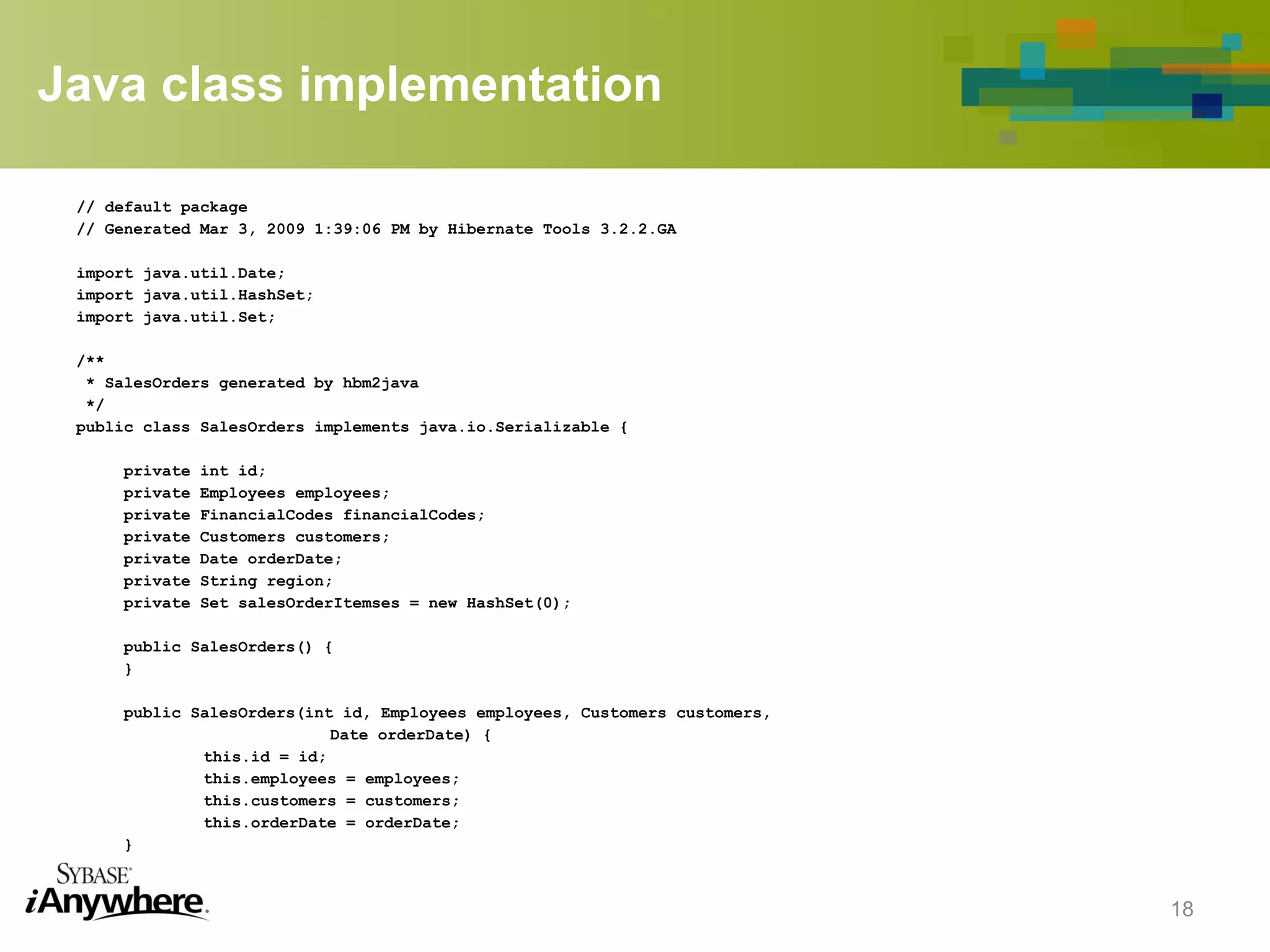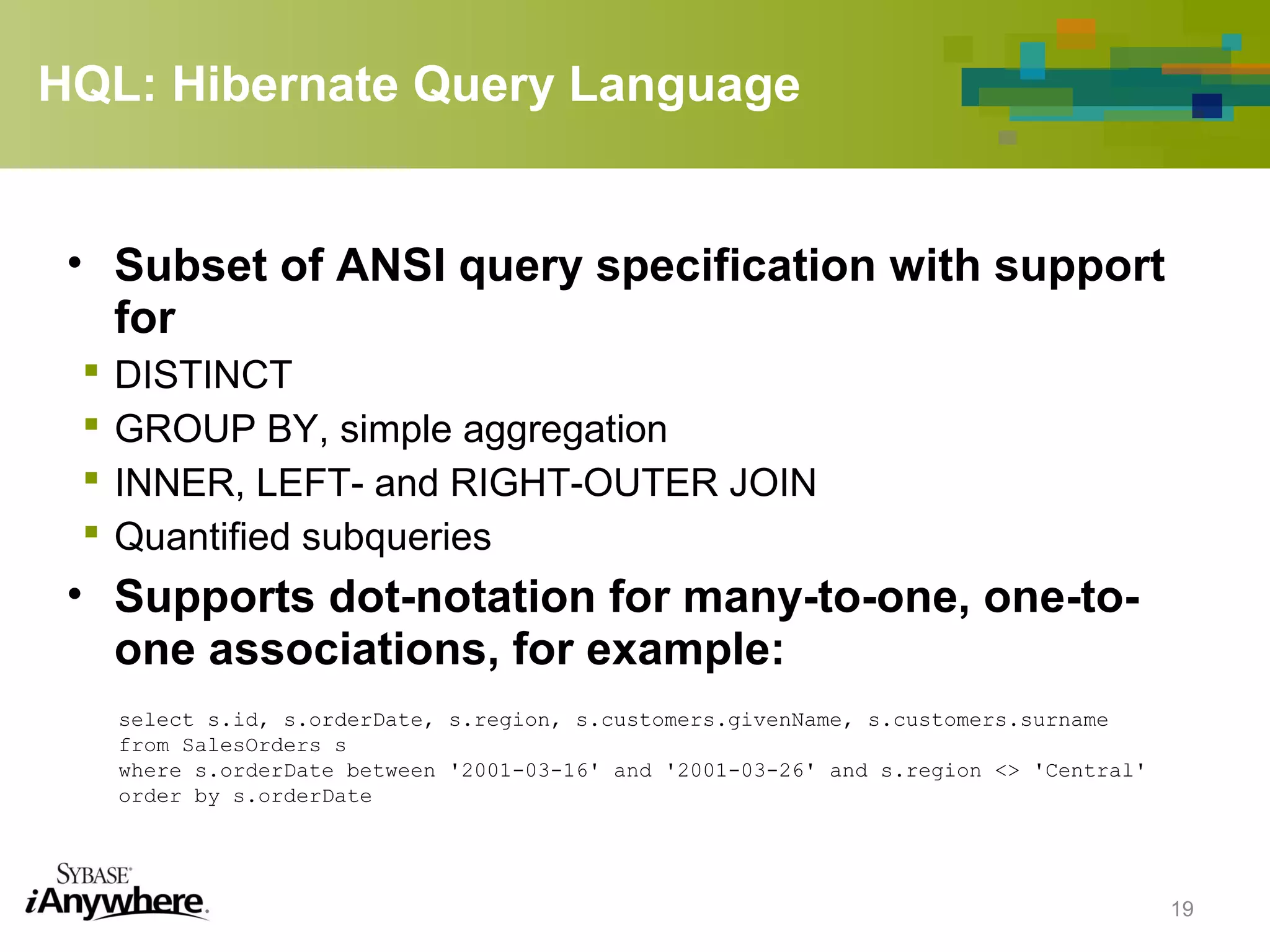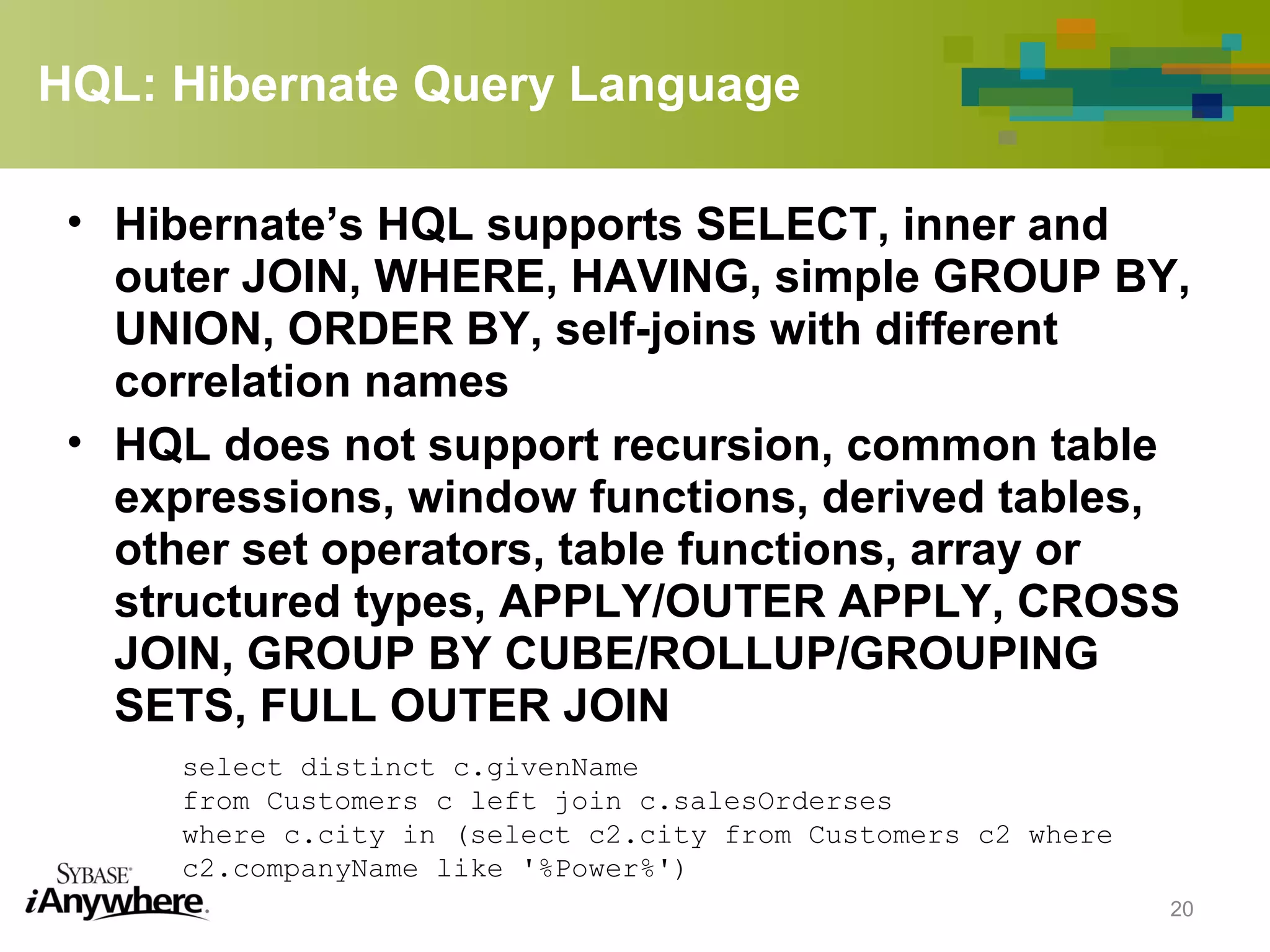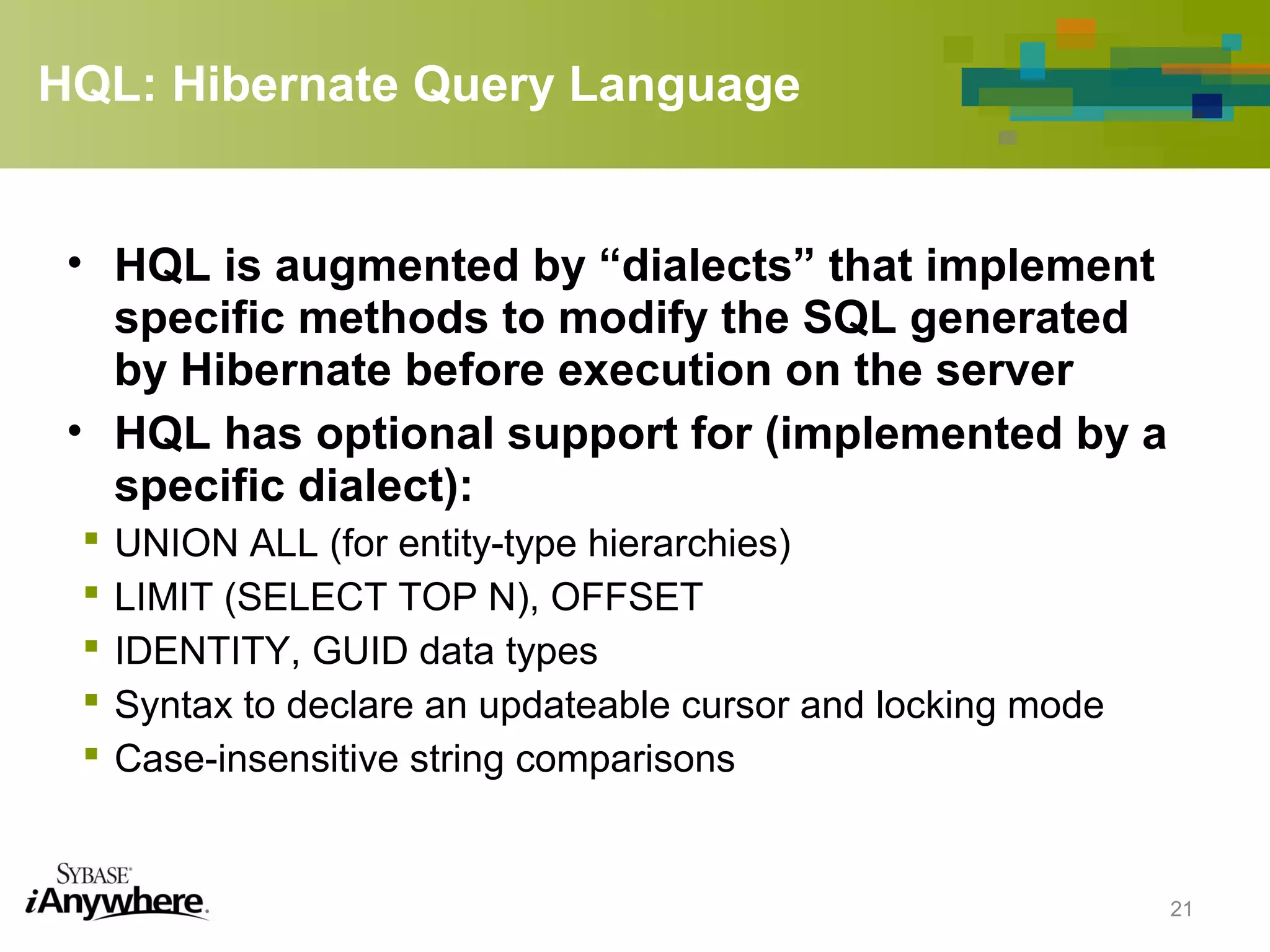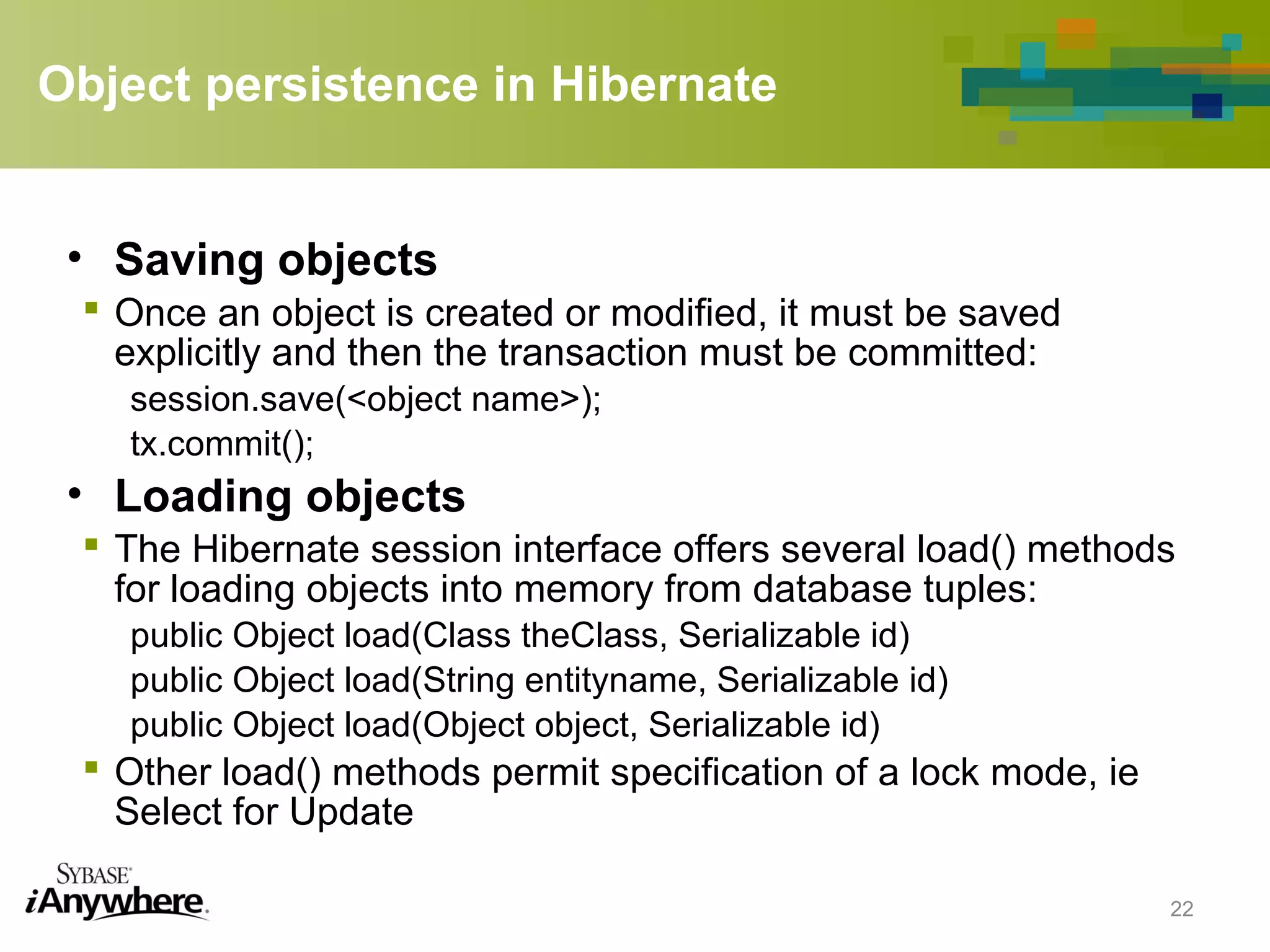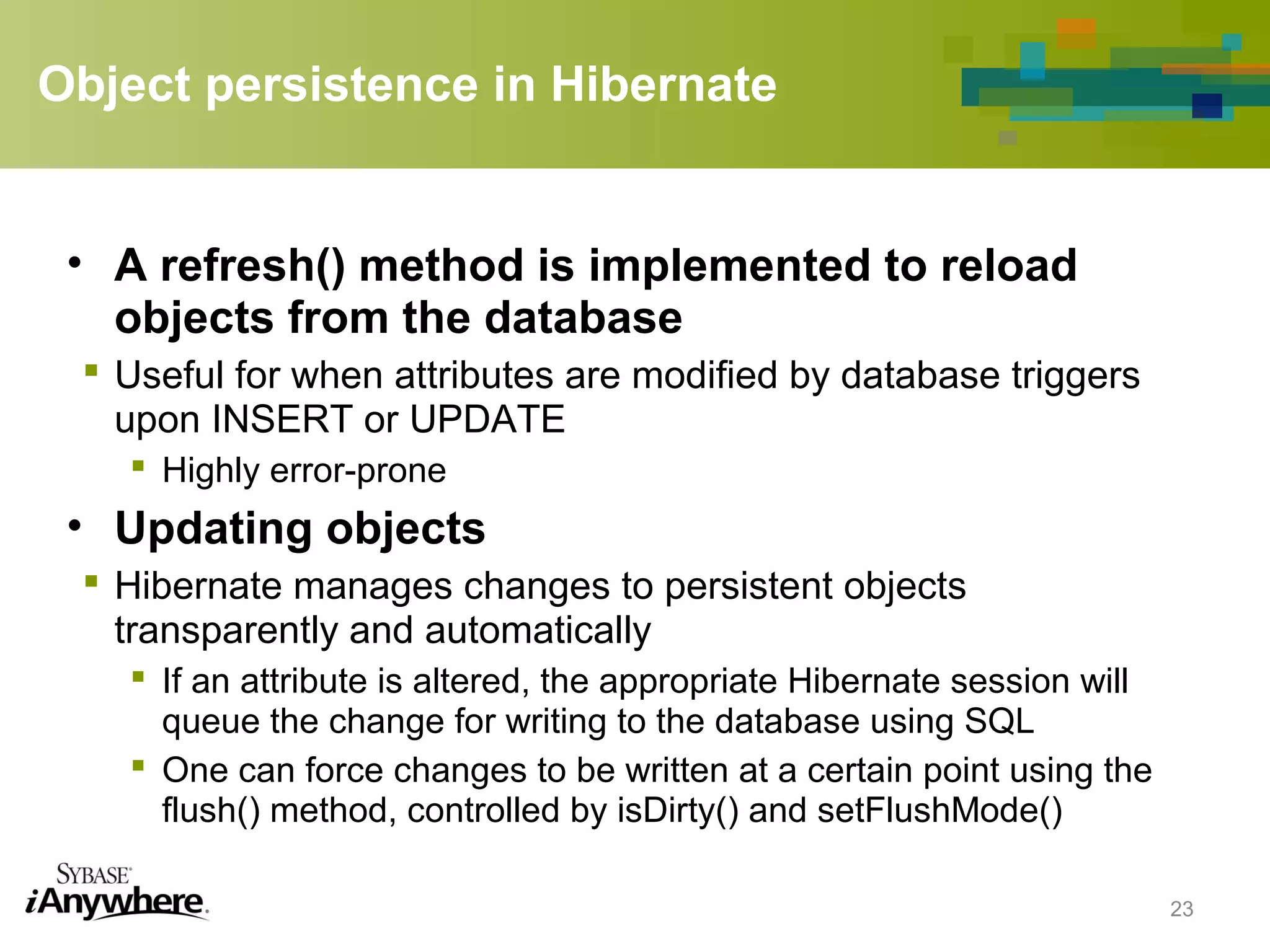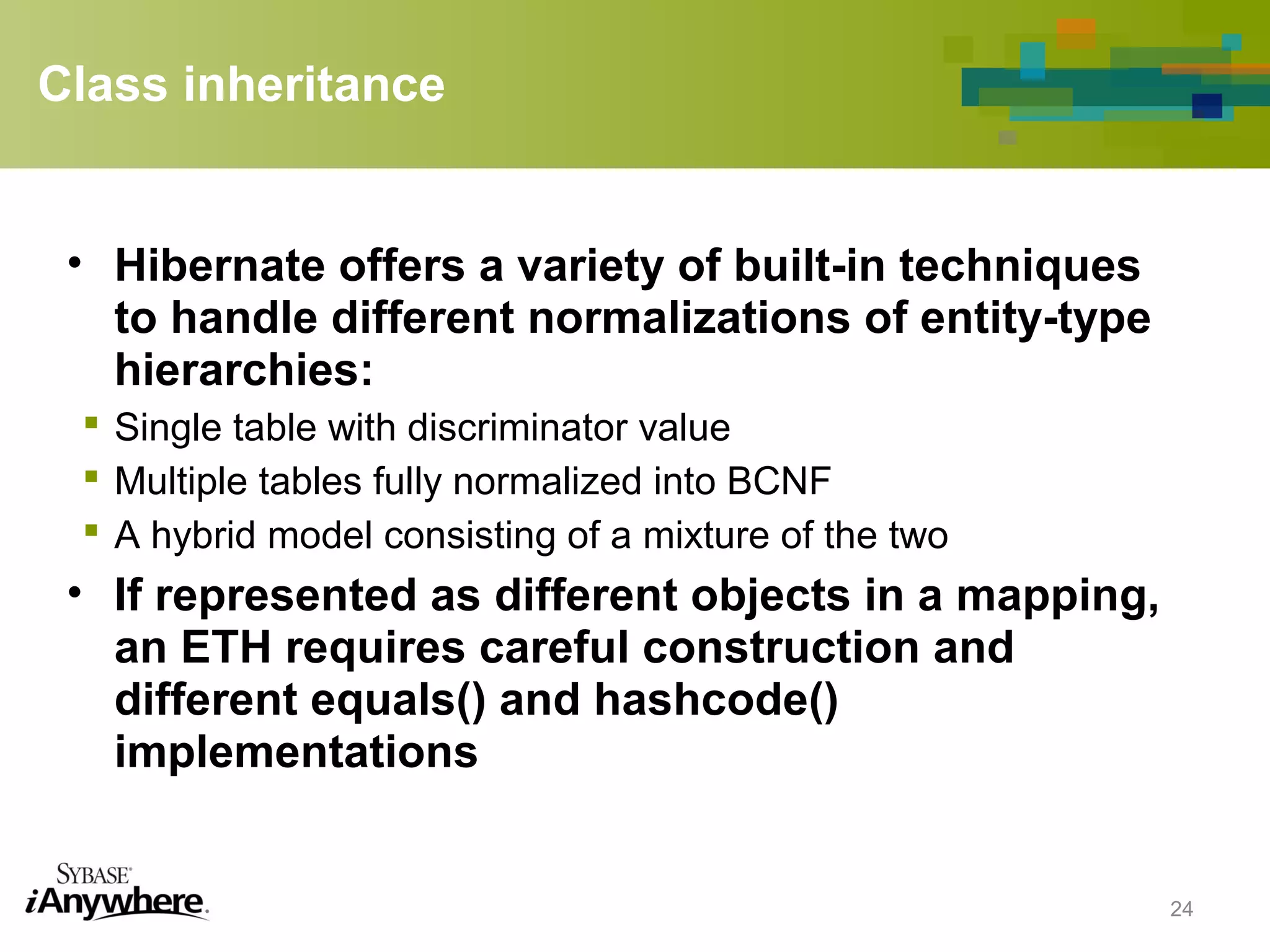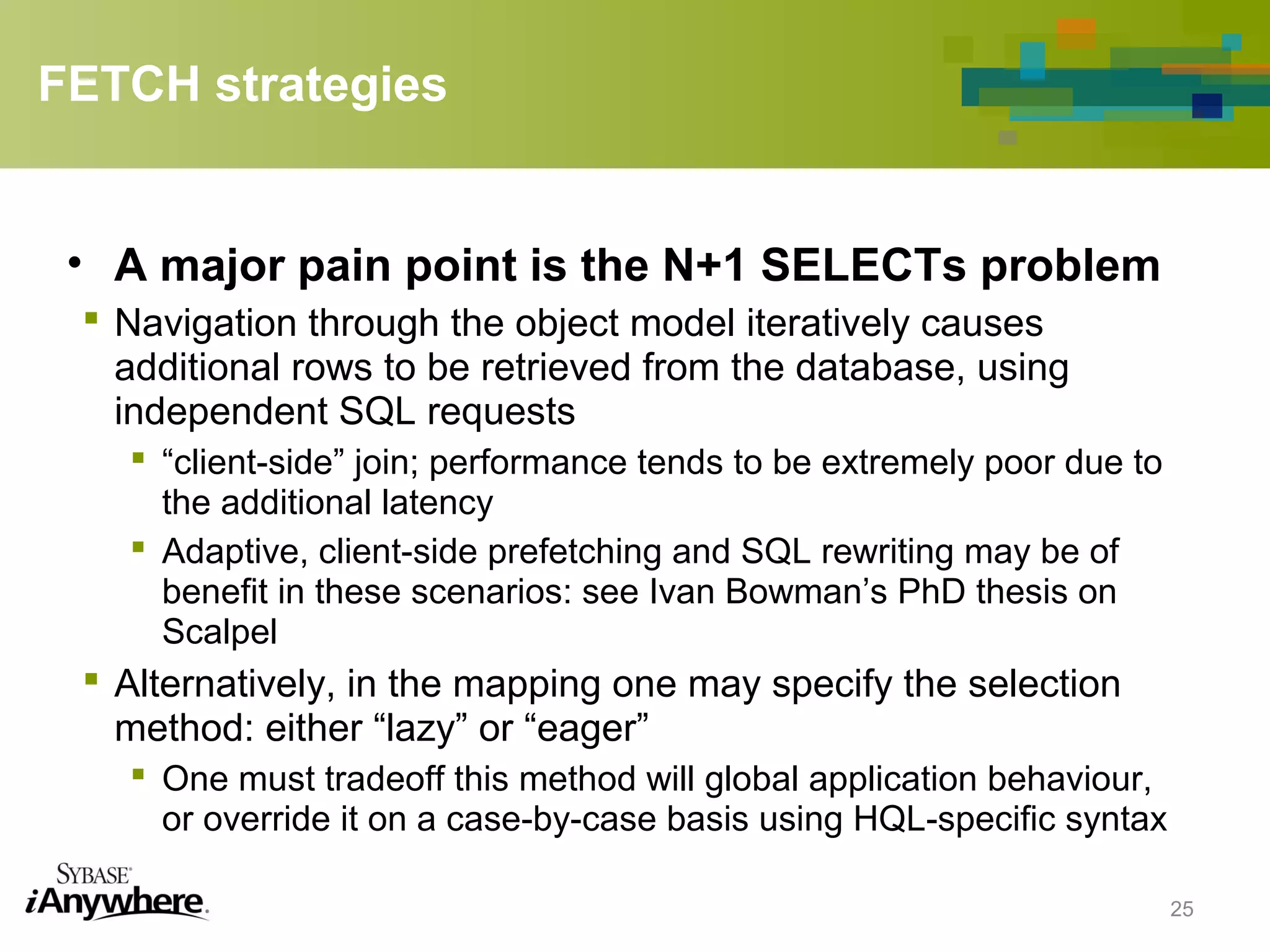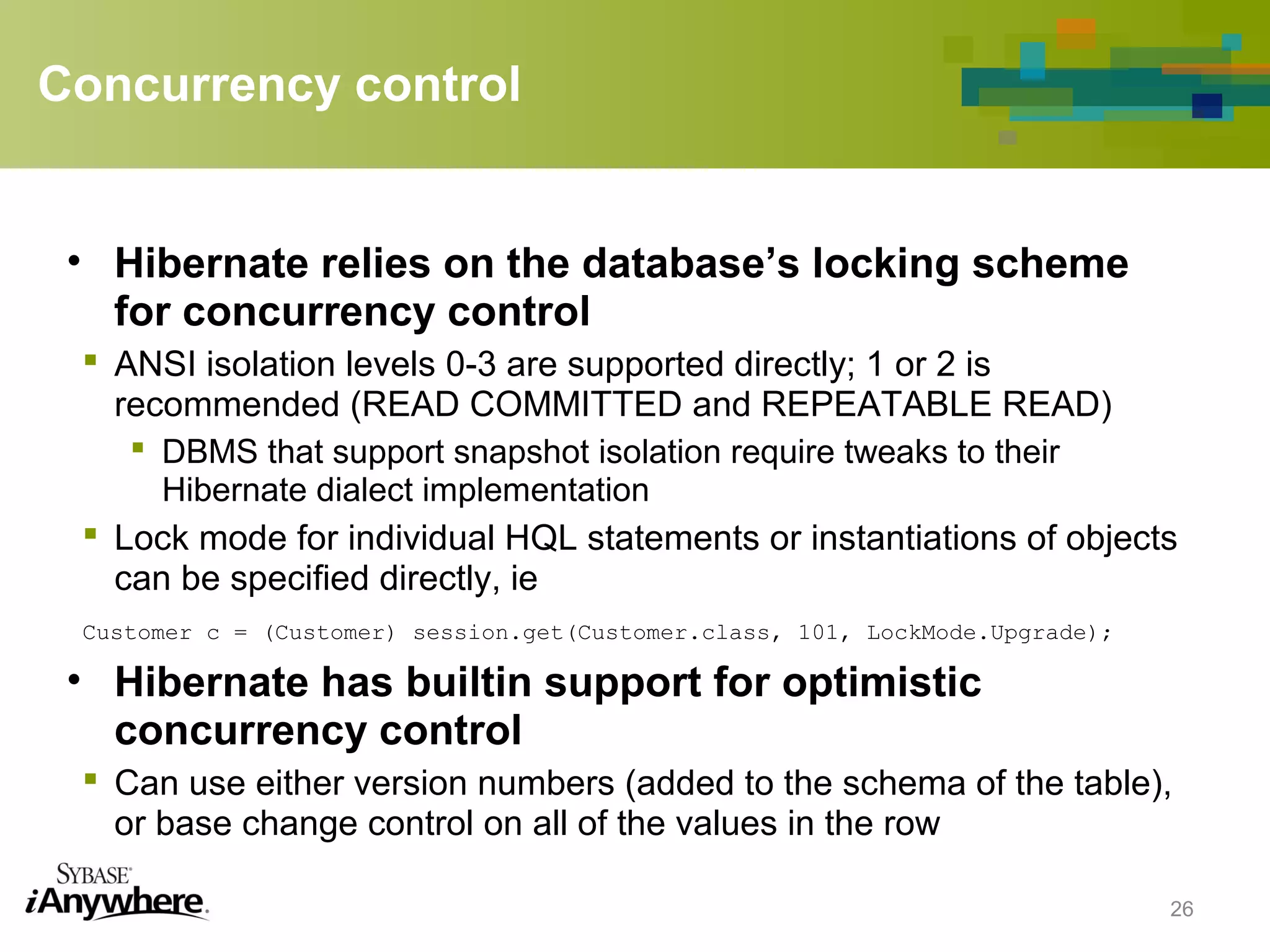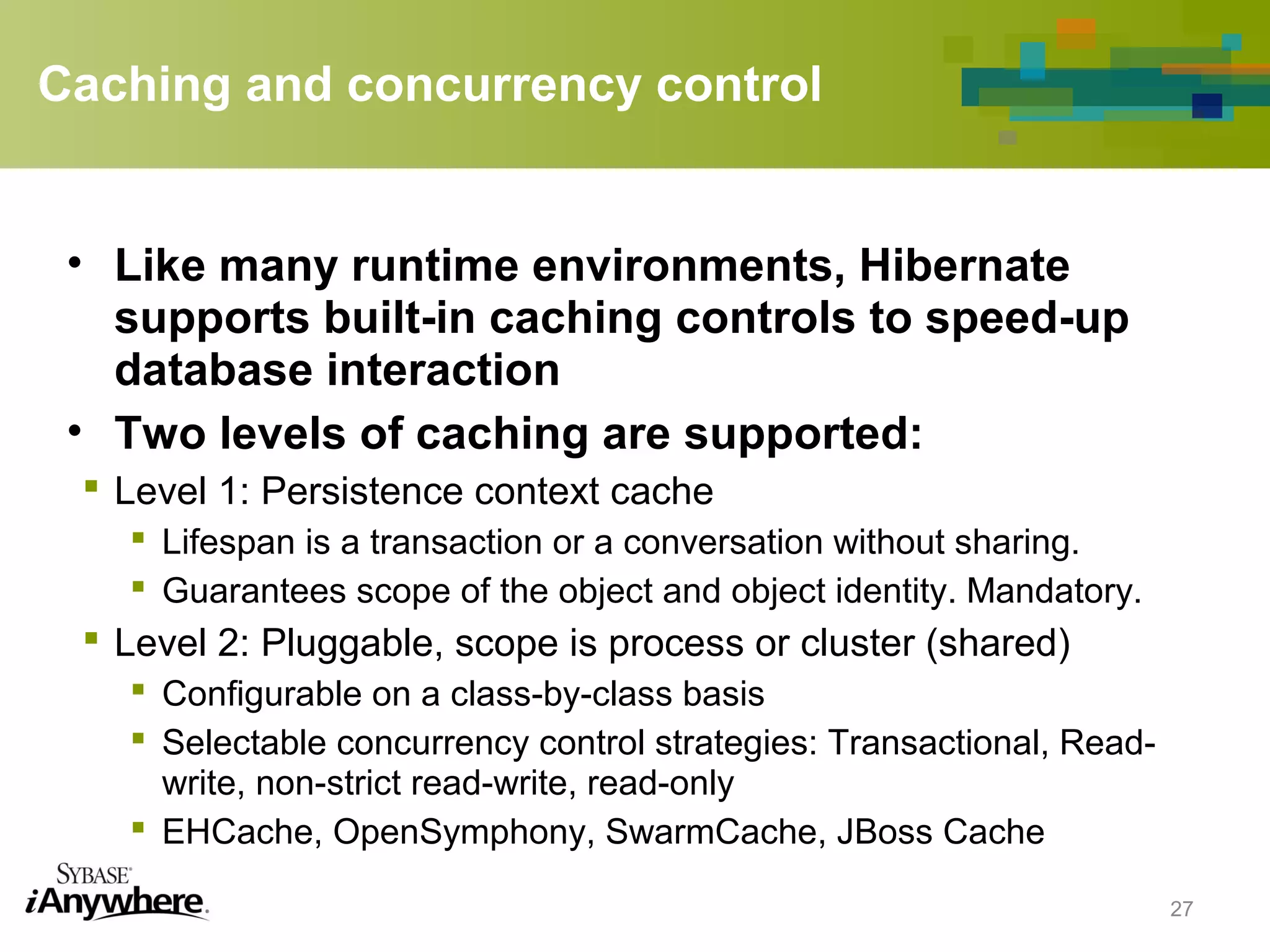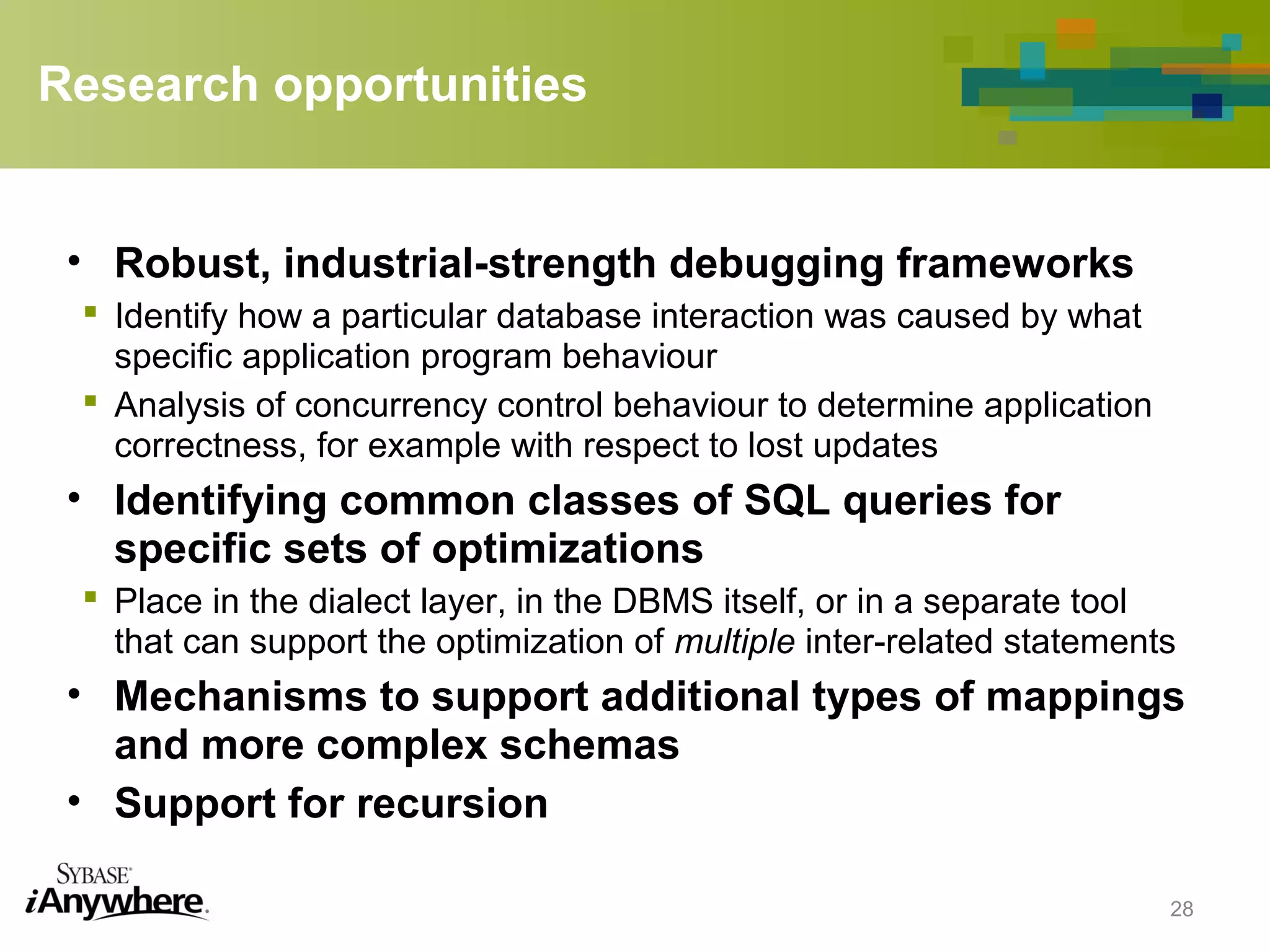Object-relational mapping (ORM) tools address the impedance mismatch between object-oriented programming and relational databases. Hibernate is a popular open-source Java ORM that uses object mapping files to define object-database relationships. It provides an object persistence mechanism and query language to retrieve and manipulate objects while insulating developers from vendor-specific SQL. Hibernate supports inheritance, caching, and concurrency control to improve performance but can introduce complexity.

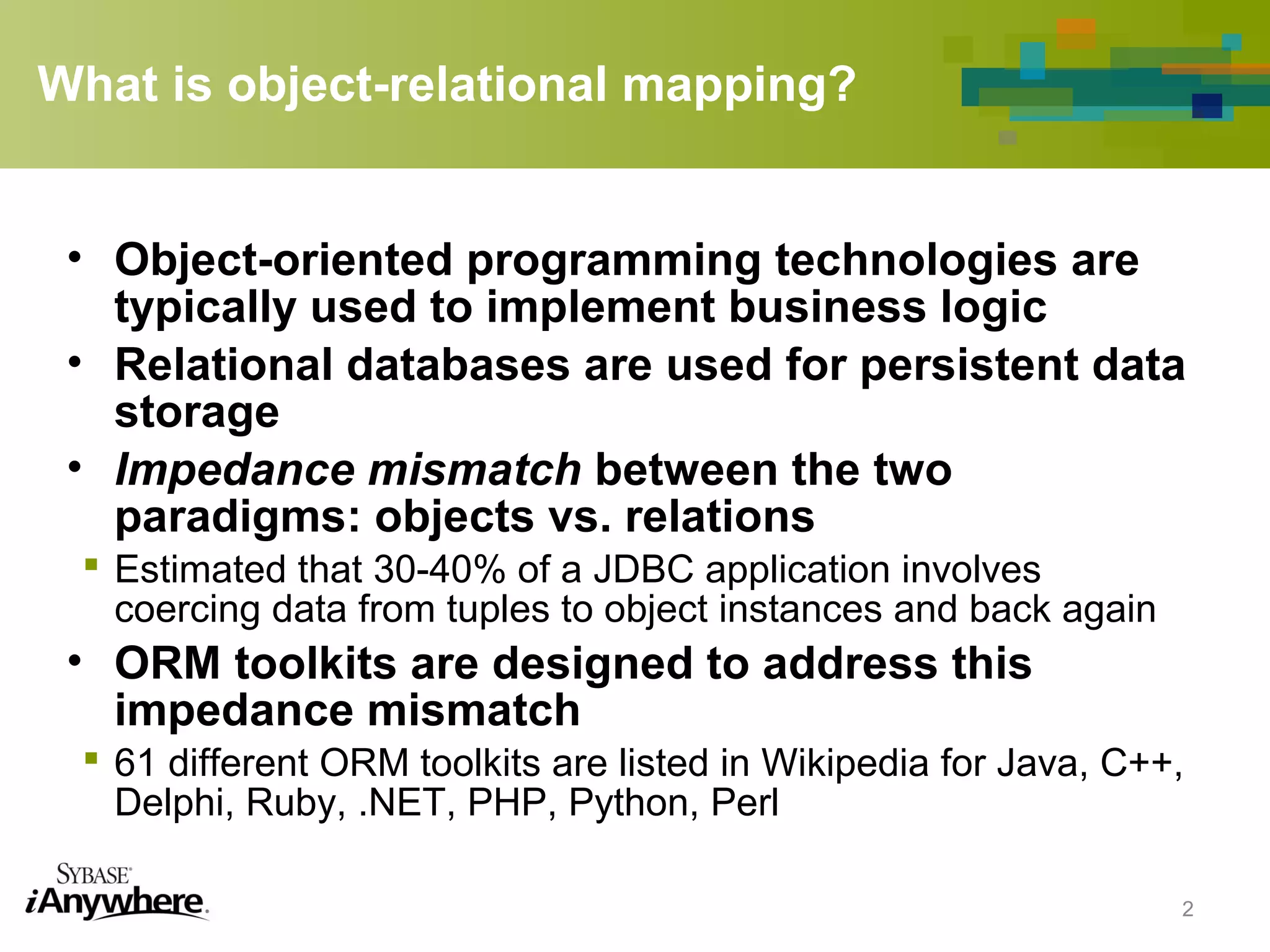
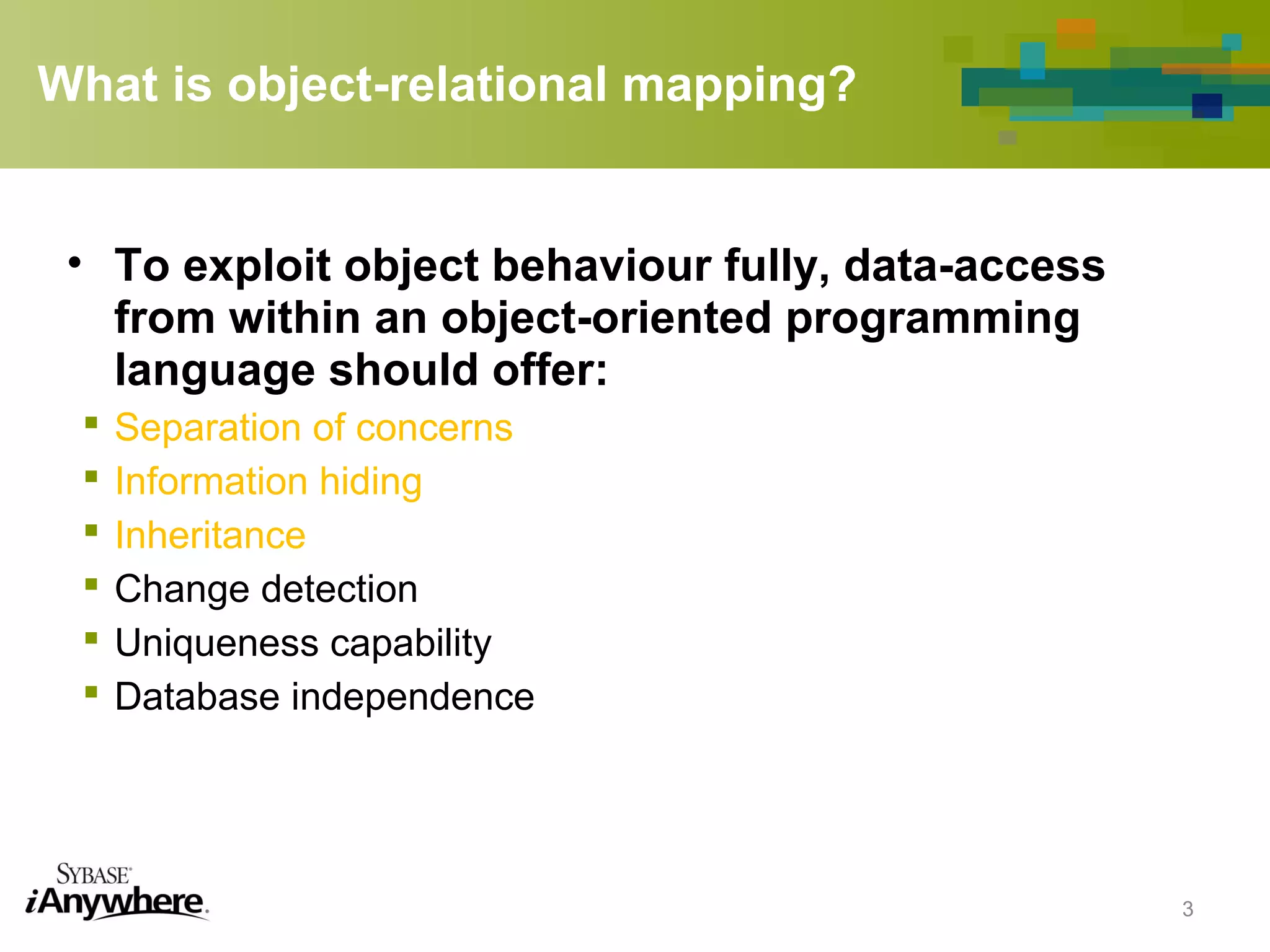
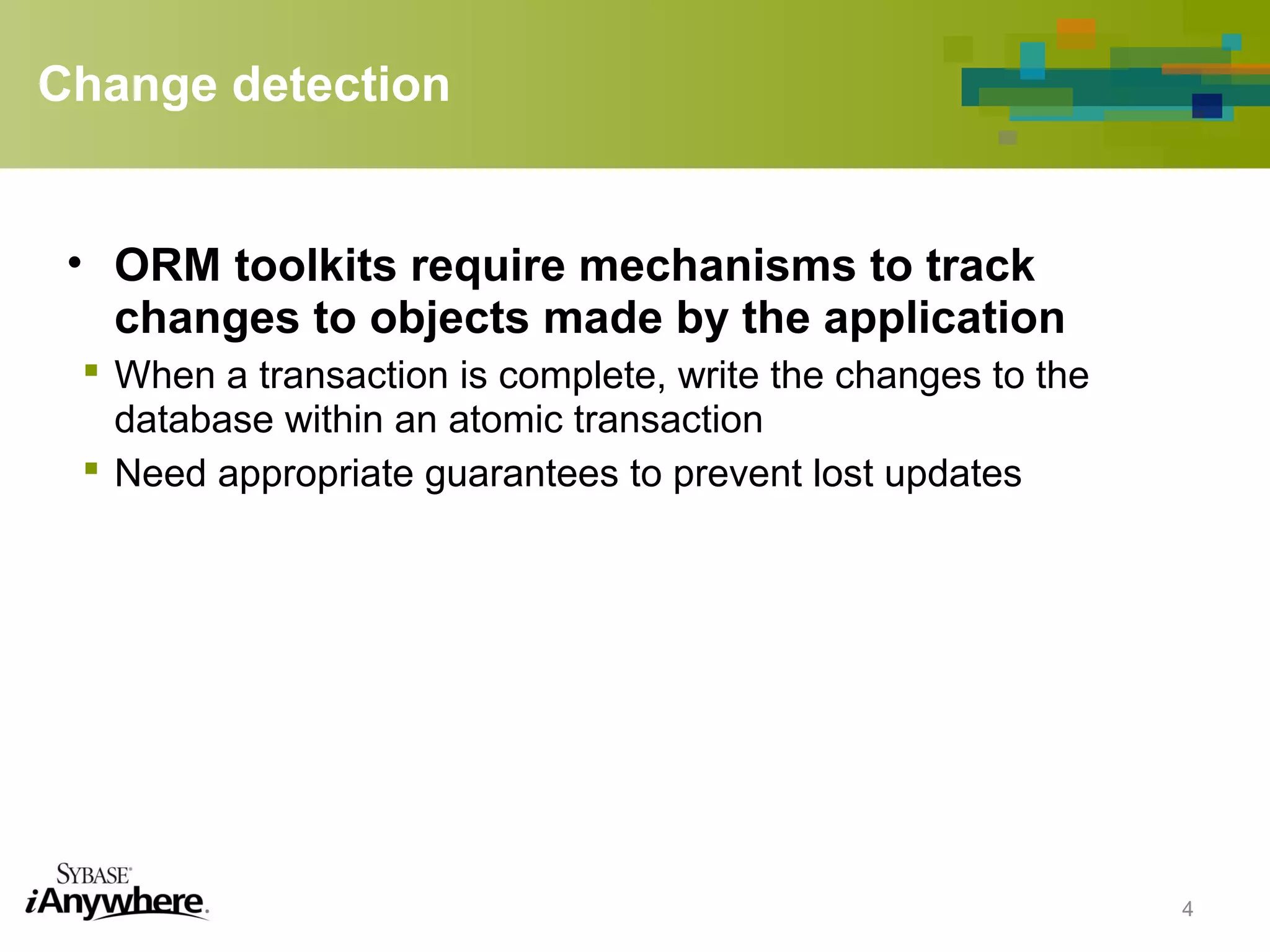
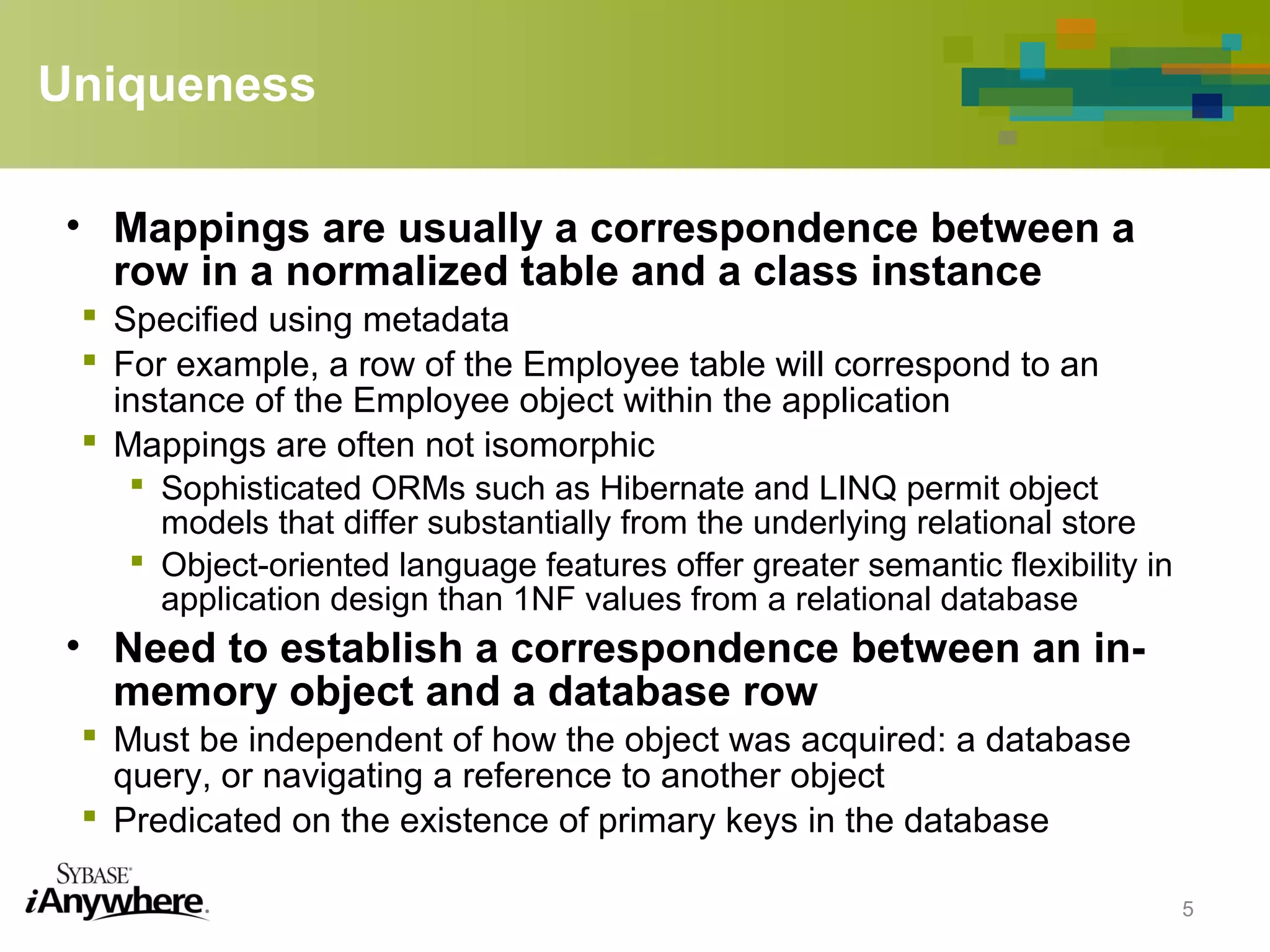

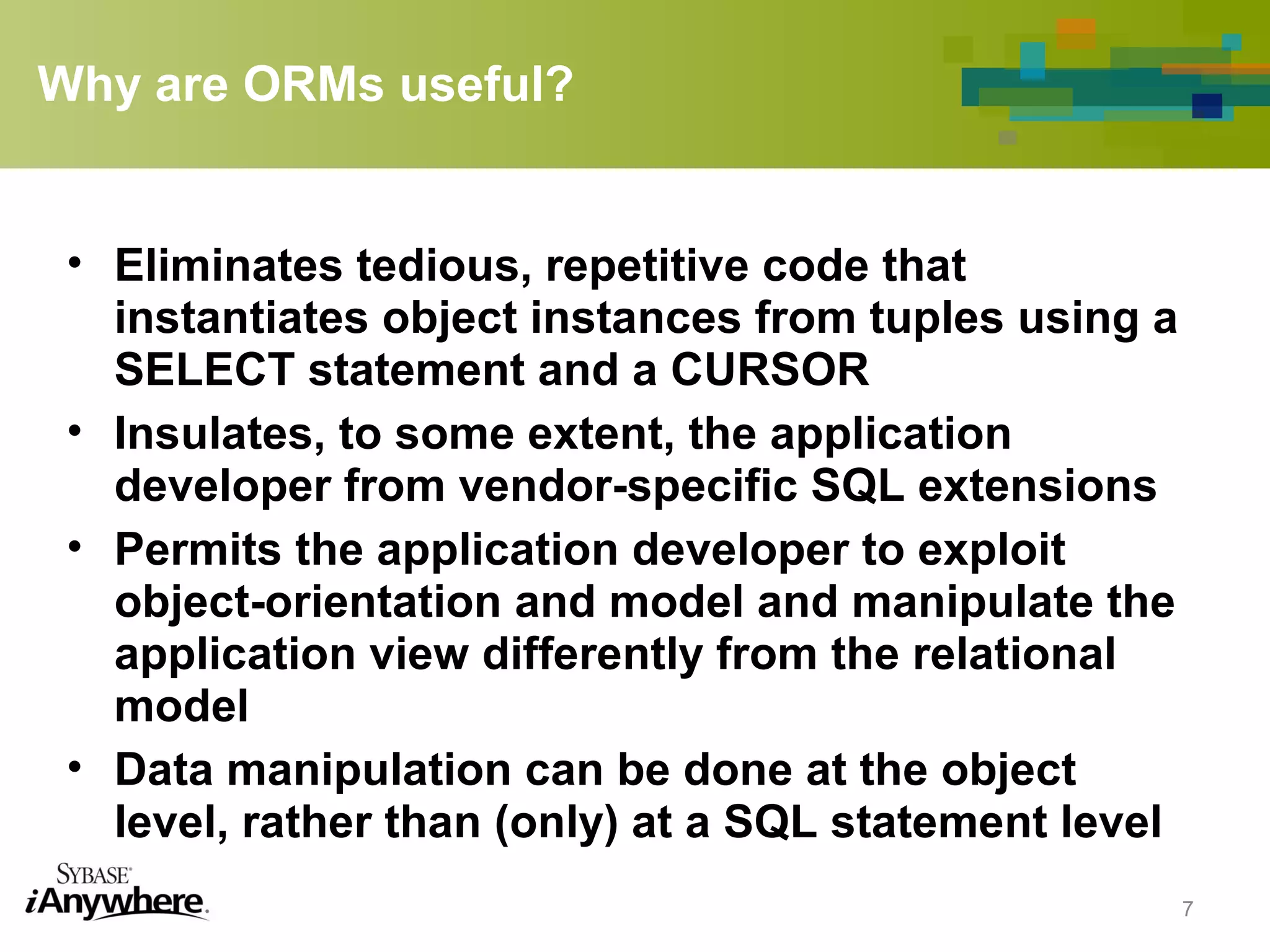
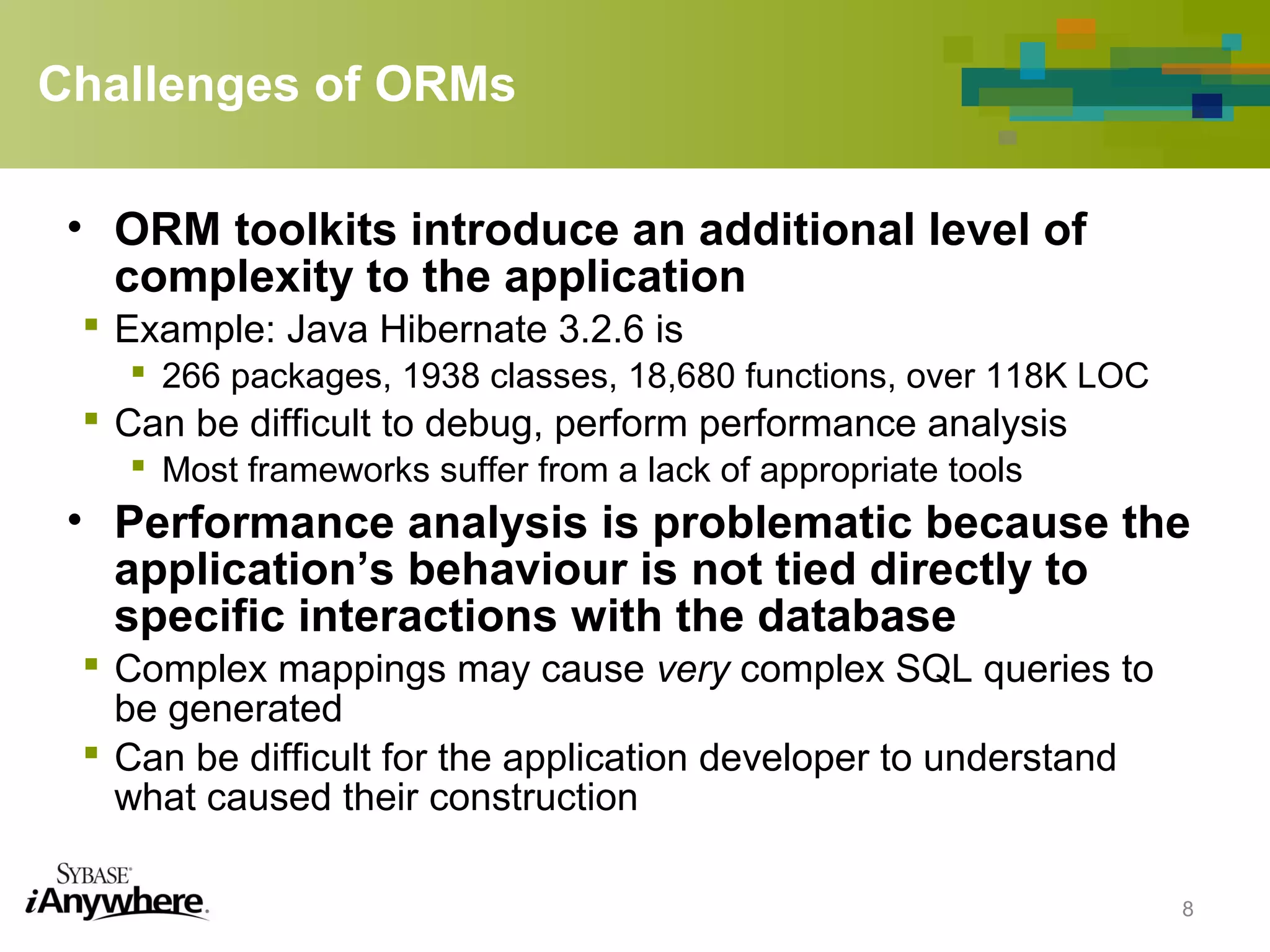
![Complex SQL (LINQ generated)
SELECT
[Project9].[ContactID] AS [ContactID],[Project9].[C1] AS [C1],[Project9].[C2] AS [C2],[Project9].[ContactID1] AS [ContactID1],[Project9].[SalesOrderID] AS
[SalesOrderID],
[Project9].[TotalDue] AS [TotalDue]
FROM ( SELECT [Distinct1].[ContactID] AS [ContactID], 1 AS [C1], [Project8].[ContactID] AS [ContactID1], [Project8].[SalesOrderID] AS [SalesOrderID],
[Project8].[TotalDue] AS [TotalDue], [Project8].[C1] AS [C2]
FROM
(SELECT DISTINCT [Extent1].[ContactID] AS [ContactID]
FROM [DBA].[Contact] AS [Extent1]
INNER JOIN [DBA].[SalesOrderHeader] AS [Extent2]
ON EXISTS (SELECT cast(1 as bit) AS [C1]
FROM ( SELECT cast(1 as bit) AS X ) AS [SingleRowTable1]
LEFT OUTER JOIN (SELECT [Extent3].[ContactID] AS [ContactID]
FROM [DBA].[Contact] AS [Extent3] WHERE [Extent2].[ContactID] = [Extent3].[ContactID] )AS [Project1] ON cast(1 as bit) = cast(1 as bit)
LEFT OUTER JOIN (SELECT [Extent4].[ContactID] AS [ContactID]
FROM [DBA].[Contact] AS [Extent4] WHERE [Extent2].[ContactID] = [Extent4].[ContactID] ) AS [Project2] ON cast(1 as bit) = cast(1 as bit)
WHERE ([Extent1].[ContactID] = [Project1].[ContactID]) OR (([Extent1].[ContactID] IS NULL) AND ([Project2].[ContactID] IS NULL)) )
) AS [Distinct1]
LEFT OUTER JOIN
(SELECT [Extent5].[ContactID] AS [ContactID], [Extent6].[SalesOrderID] AS [SalesOrderID], [Extent6].[TotalDue] AS [TotalDue], 1 AS [C1]
FROM [DBA].[Contact] AS [Extent5]
INNER JOIN [DBA].[SalesOrderHeader] AS [Extent6]
ON EXISTS (SELECT cast(1 as bit) AS [C1]
FROM ( SELECT cast(1 as bit) AS X ) AS [SingleRowTable2]
LEFT OUTER JOIN (SELECT [Extent7].[ContactID] AS [ContactID]
FROM [DBA].[Contact] AS [Extent7] WHERE [Extent6].[ContactID] = [Extent7].[ContactID] )AS [Project5] ON cast(1 as bit) = cast(1 as bit)
LEFT OUTER JOIN (SELECT [Extent8].[ContactID] AS [ContactID]
FROM [DBA].[Contact] AS [Extent8] WHERE [Extent6].[ContactID] = [Extent8].[ContactID] )AS [Project6] ON cast(1 as bit) = cast(1 as bit)
WHERE ([Extent5].[ContactID] = [Project5].[ContactID]) OR (([Extent5].[ContactID] IS NULL) AND ([Project6].[ContactID] IS NULL))
)
) AS [Project8]
ON ([Project8].[ContactID] = [Distinct1].[ContactID]) OR (([Project8].[ContactID] IS NULL) AND ([Distinct1].[ContactID] IS NULL))
) AS [Project9]
ORDER BY [Project9].[ContactID] ASC, [Project9].[C2] ASC
9](https://image.slidesharecdn.com/ormandhibernate-150502051108-conversion-gate01/75/Orm-and-hibernate-9-2048.jpg)
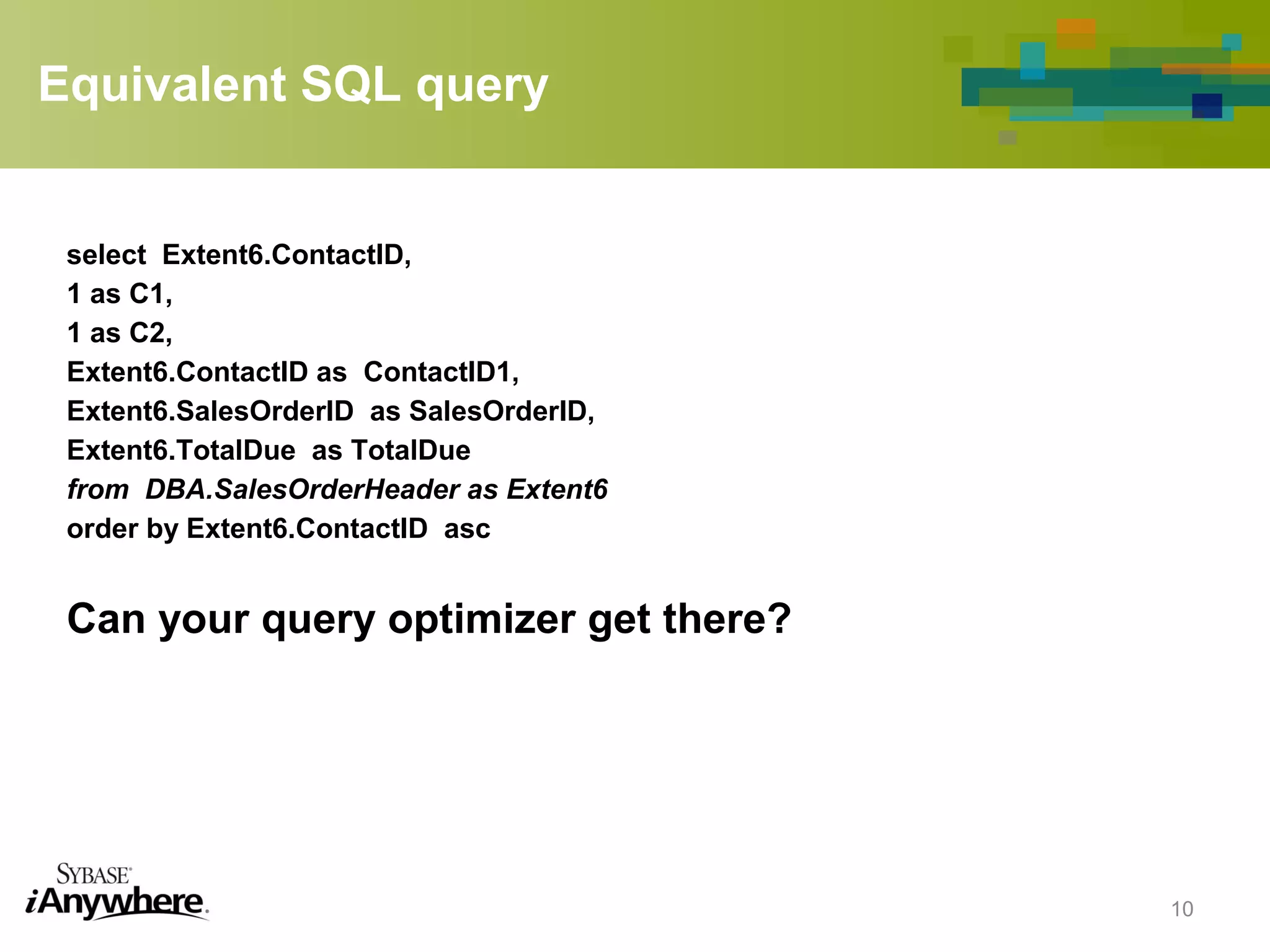
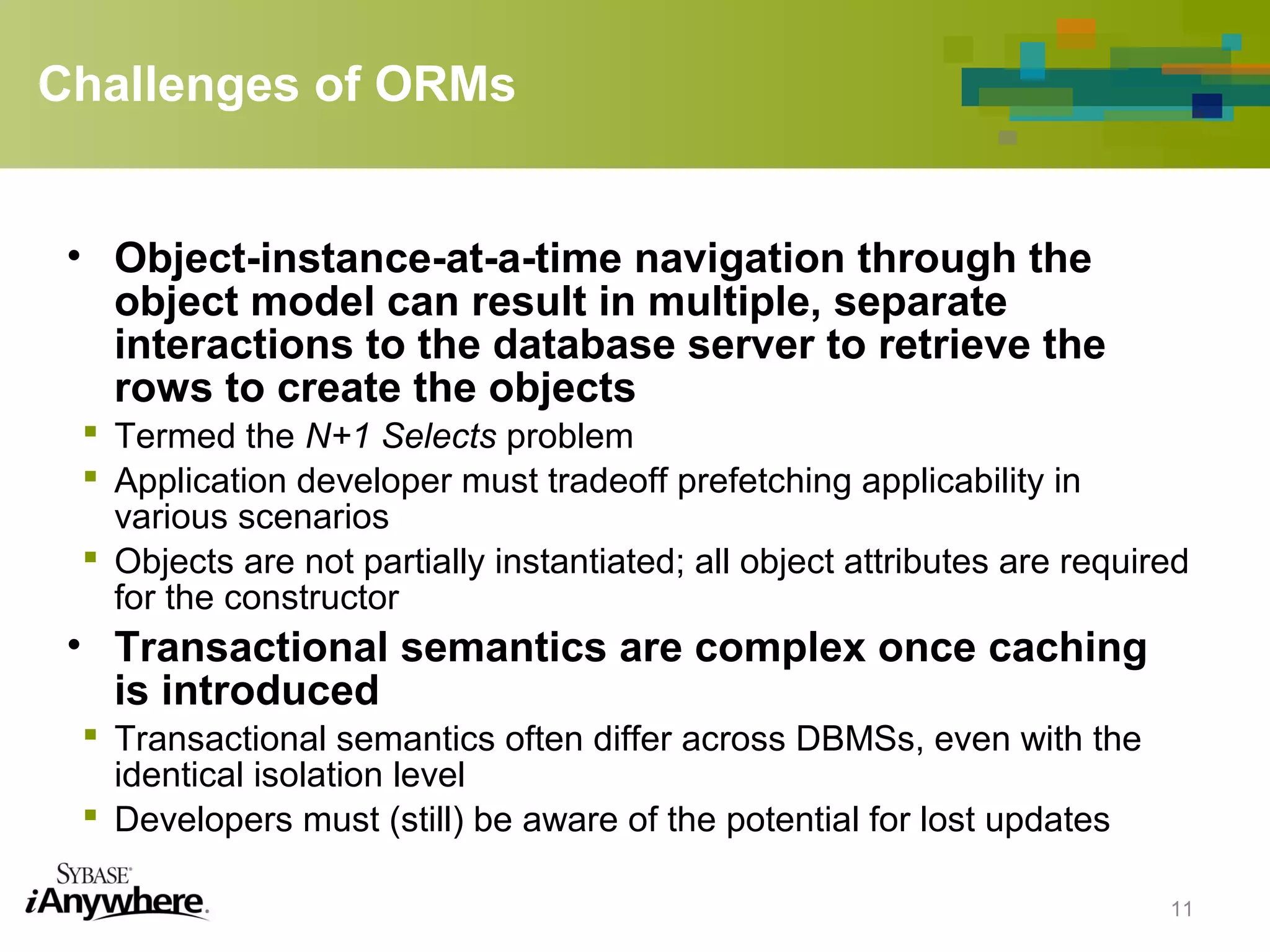
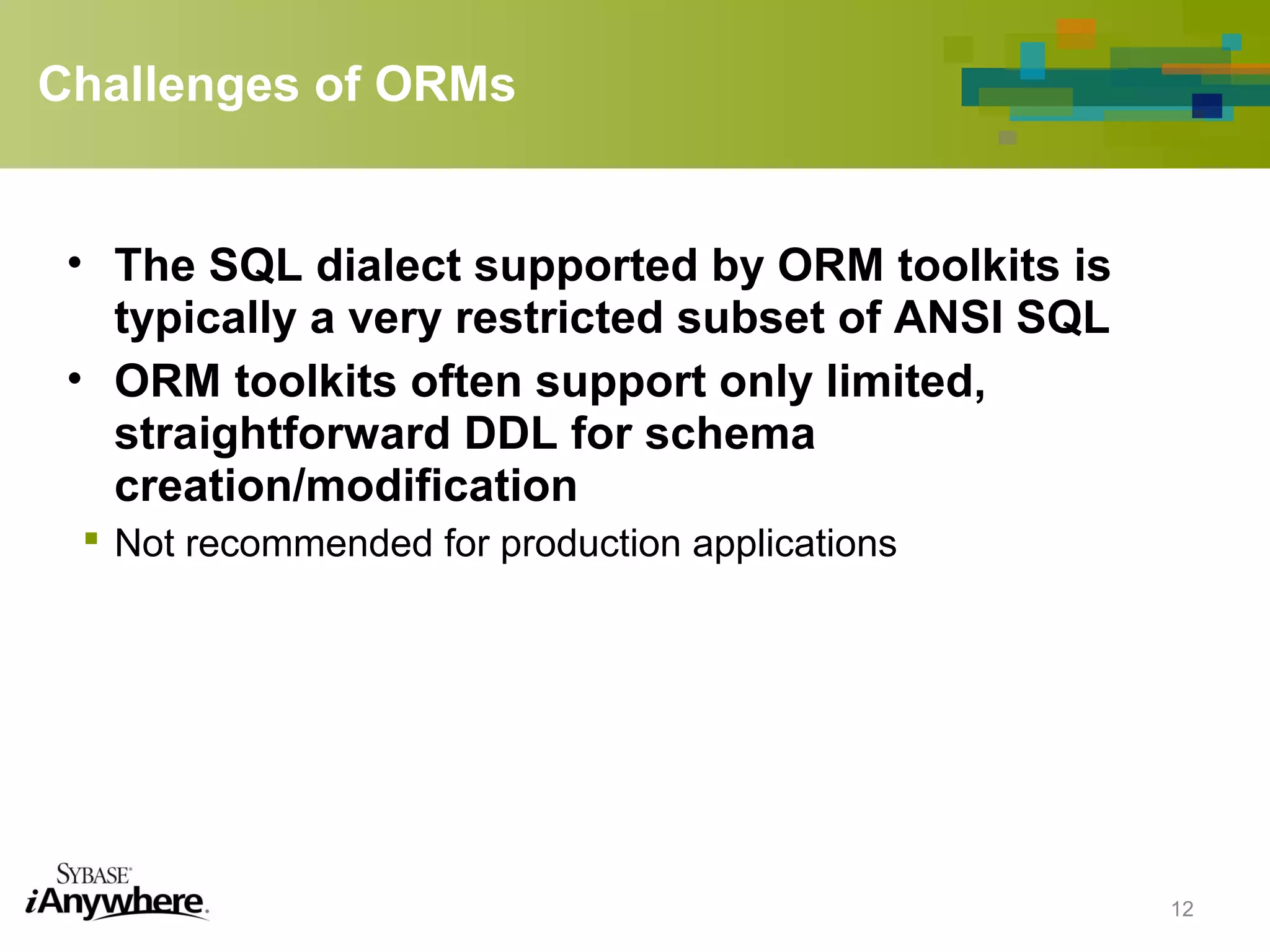
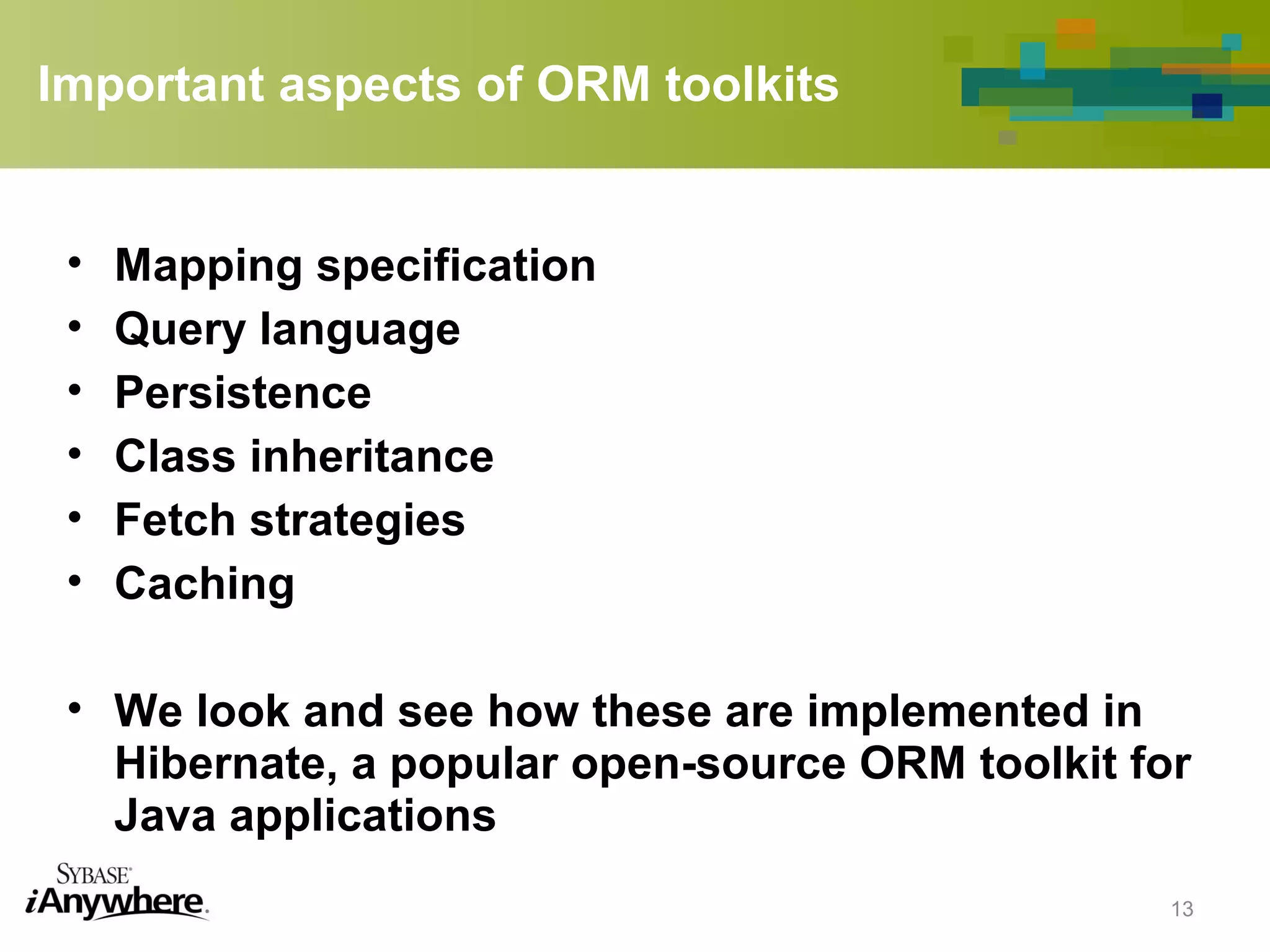
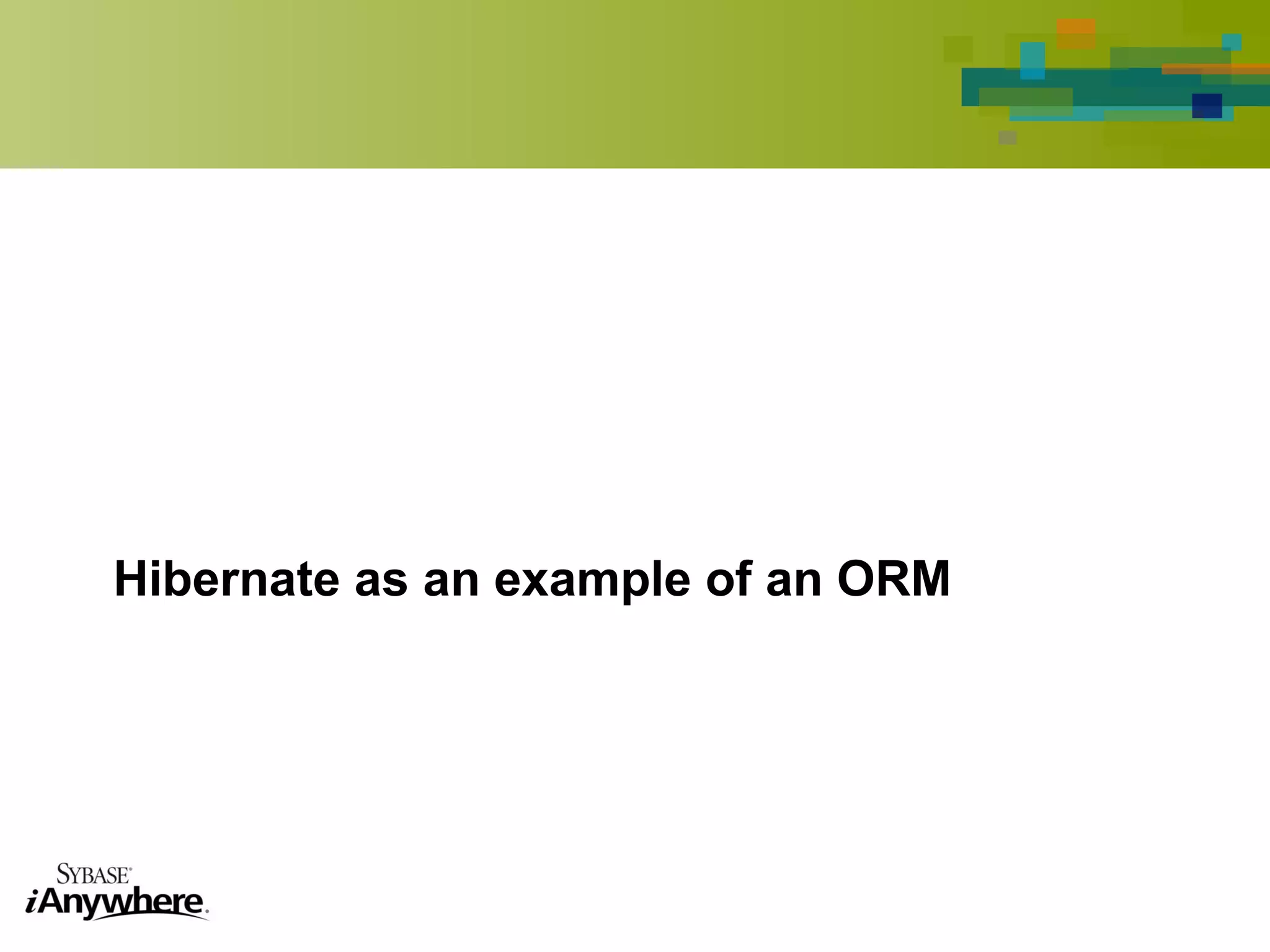
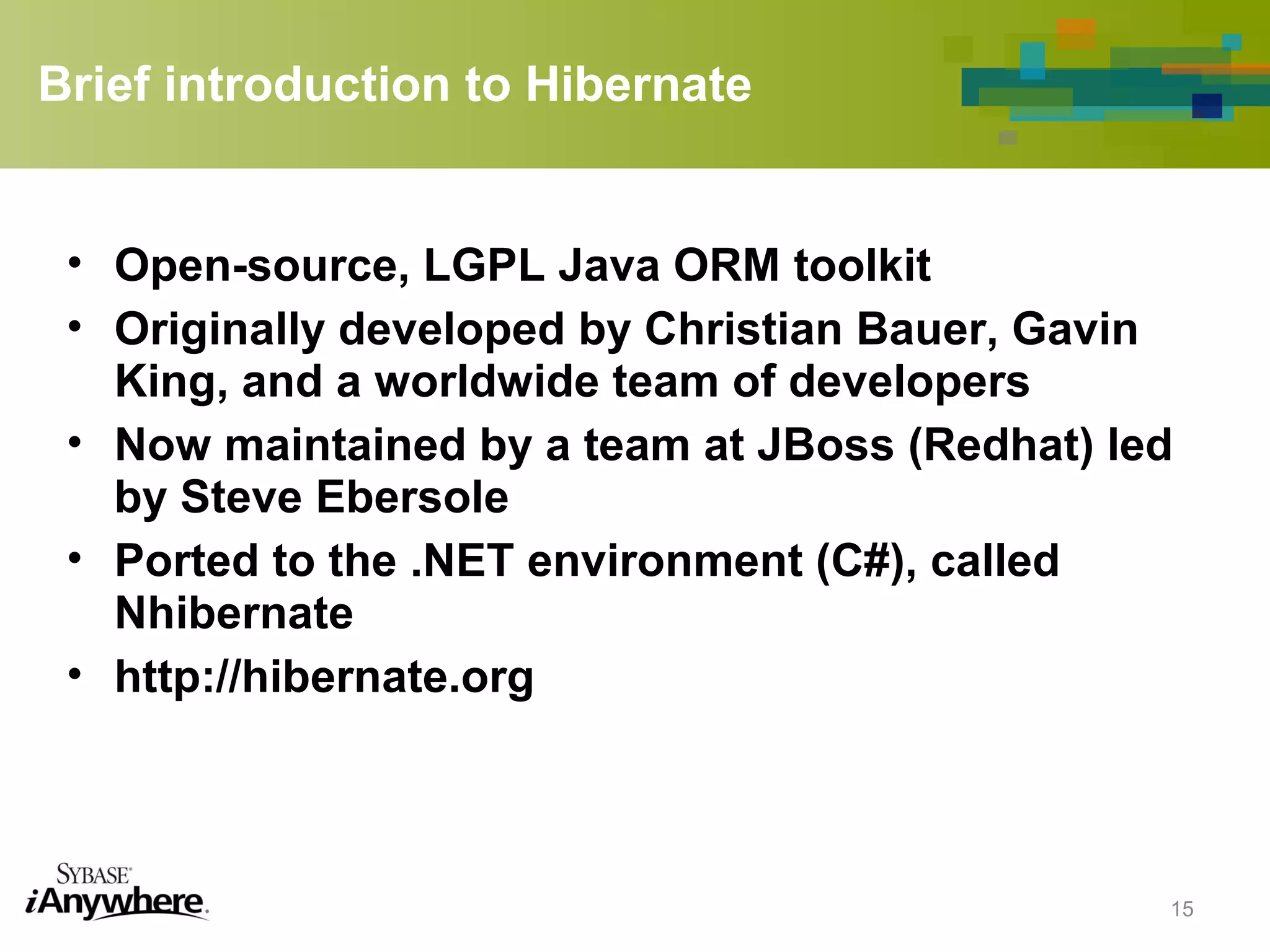
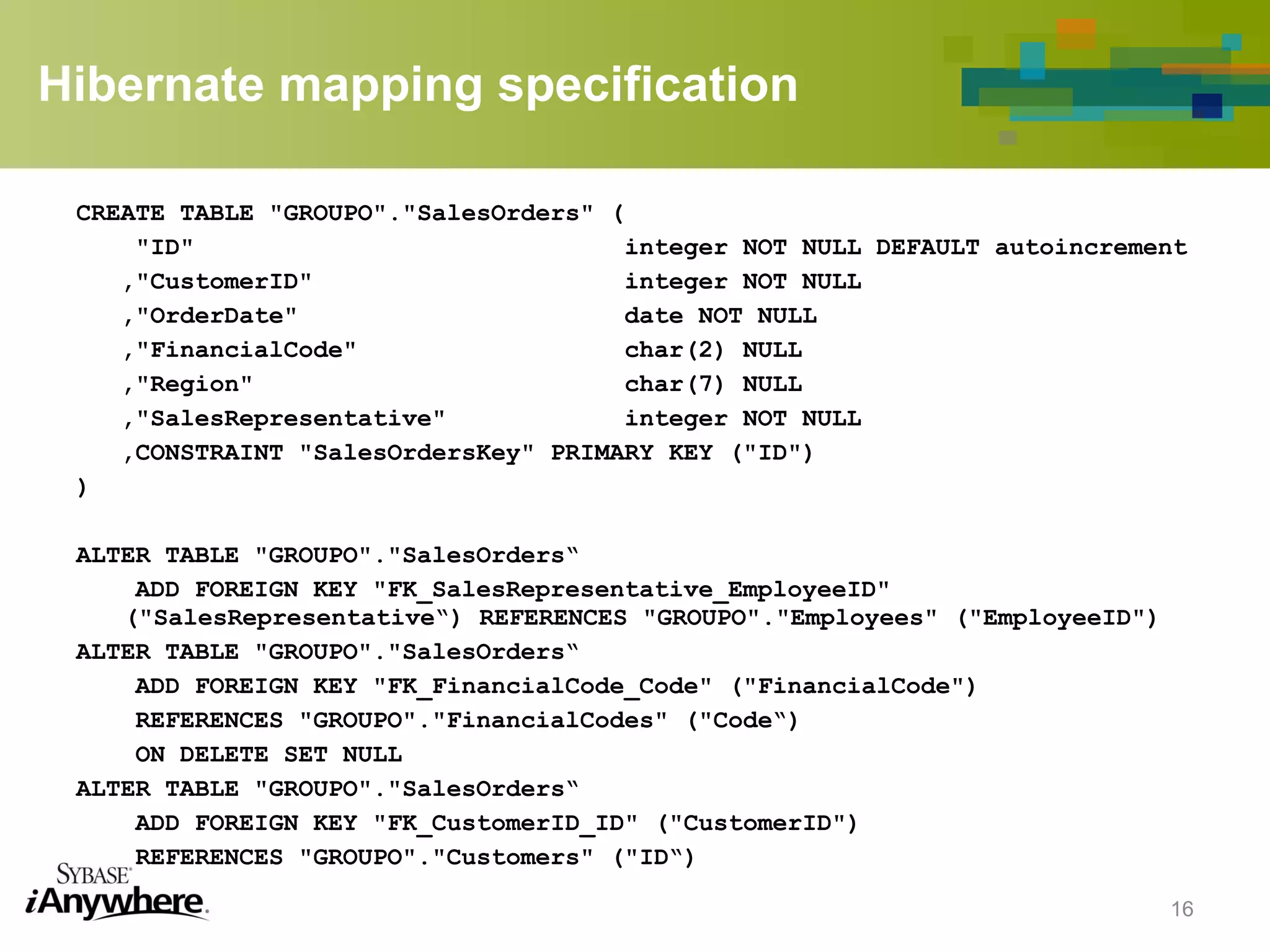
![Hibernate mapping specification
Hibernate mapping file SalesOrders.hbm.xml:
<?xml version="1.0"?>
<!DOCTYPE hibernate-mapping PUBLIC "-//Hibernate/Hibernate Mapping DTD 3.0//EN"
"http://hibernate.sourceforge.net/hibernate-mapping-3.0.dtd">
<!-- Generated Mar 3, 2009 11:59:55 AM by Hibernate Tools 3.2.2.GA -->
<hibernate-mapping>
<class name="SalesOrders" table="SalesOrders">
<comment>sales orders that customers have submitted to the sporting goods company</comment>
<id name="id" type="int">
<column name="ID" />
<generator class="assigned" />
</id>
<many-to-one name="employees" class="Employees" fetch="select">
<column name="SalesRepresentative" not-null="true" />
</many-to-one>
<many-to-one name="financialCodes" class="FinancialCodes" fetch="select">
<column name="FinancialCode" length="2" />
</many-to-one>
<many-to-one name="customers" class="Customers" fetch="select">
<column name="CustomerID" not-null="true" />
</many-to-one>
<property name="orderDate" type="date">
<column name="OrderDate" length="10" not-null="true" />
</property> .............[snip]
</class>
</hibernate-mapping>
17](https://image.slidesharecdn.com/ormandhibernate-150502051108-conversion-gate01/75/Orm-and-hibernate-17-2048.jpg)
